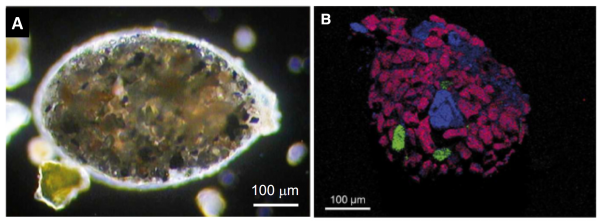And one more story from Timelord #zircon for the #MinCup23 Grand Final – one I just learnt last year thanks to the Mineral Cup and Caroline Thaler (https://blog.eag.eu.com/news/caroline-thaler-climate-tech-project-entrepreneur/). This one blew me away because it was such an unexpected link to #zircon and has some intriguing implications…
This story has us diving into the Adriatic Sea to look at some very small creatures called foraminifera. Foraminifera are these amazing single-celled organisms that feed with strands of ectoplasm from their cell wall and often build a small shell around themselves from various materials. The microscopic shells can be important markers in the sedimentary record for time and environmental conditions. (I still fondly remember a University undergrad assignment being amazed by the diversity of shell types while spending hours picking through a collection of foraminifera shells under a microscope. It was also a very Zen exercise and pretty everyone in the class spent extra time doing it…).
Somewhere, right now, in the Adriatic Sea there is a species of benthic foraminifera called Psammophaga zirconia that are literally surrounding themselves with #zircon grains. P. zirconia’s specialty is picking zircon grains in the sediment to make it’s shell (see the Sabbatini et al 2016 paper at https://www.researchgate.net/publication/299381635_Selective_zircon_accumulation_in_a_new_benthic_foraminifer_Psammophaga_zircona_sp_nov). Not quite sure why, perhaps it’s a buoyancy thing to pick denser minerals stay anchored on the sea floor, but P. zirconia is going to a lot of trouble to select #zircon in particular which isn’t common in the surrounding sediment.
It also has interesting implications for the microfossil record because foraminifera like P. zirconia may have been here since the Precambrian and may have left little accumulations of zircon in ancient sedimentary rocks if we know to look for them. I also think there may be some interesting implications in understanding *how* a single-celled organism is able to differentiate minerals…
So, if Psammophaga zirconia is working hard to pick #zircon, so can you! Vote #zircon in the #MinCup23 final
https://www.mineralcup.org/2023/campaigns/round-5-match-1
This story has us diving into the Adriatic Sea to look at some very small creatures called foraminifera. Foraminifera are these amazing single-celled organisms that feed with strands of ectoplasm from their cell wall and often build a small shell around themselves from various materials. The microscopic shells can be important markers in the sedimentary record for time and environmental conditions. (I still fondly remember a University undergrad assignment being amazed by the diversity of shell types while spending hours picking through a collection of foraminifera shells under a microscope. It was also a very Zen exercise and pretty everyone in the class spent extra time doing it…).
Somewhere, right now, in the Adriatic Sea there is a species of benthic foraminifera called Psammophaga zirconia that are literally surrounding themselves with #zircon grains. P. zirconia’s specialty is picking zircon grains in the sediment to make it’s shell (see the Sabbatini et al 2016 paper at https://www.researchgate.net/publication/299381635_Selective_zircon_accumulation_in_a_new_benthic_foraminifer_Psammophaga_zircona_sp_nov). Not quite sure why, perhaps it’s a buoyancy thing to pick denser minerals stay anchored on the sea floor, but P. zirconia is going to a lot of trouble to select #zircon in particular which isn’t common in the surrounding sediment.
It also has interesting implications for the microfossil record because foraminifera like P. zirconia may have been here since the Precambrian and may have left little accumulations of zircon in ancient sedimentary rocks if we know to look for them. I also think there may be some interesting implications in understanding *how* a single-celled organism is able to differentiate minerals…
So, if Psammophaga zirconia is working hard to pick #zircon, so can you! Vote #zircon in the #MinCup23 final
https://www.mineralcup.org/2023/campaigns/round-5-match-1
Vote in the Finals
You’ve narrowed the list down from 32 minerals to just these finalists. It’s a study of contrasts between a pair of powerhouse minerals as you select which one will join the elite list of Mineral Cup champions.Mika McKinnon (Mineral Cup)

